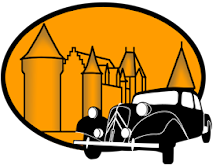Scientific Name: Issoria lathonia.
English Name: Queen of Spain Fritillary.
French Name: Le Petit Nacré (='the small mother of pearl').
5 Key Characters:
Habitat: Fallow land, flower rich grassland. In the autumn often seen warming themselves in the sun on ploughed earth or stubble fields. Known to be remarkably tolerant of heavy metal pollution.They also like our potager (vegetable garden) where the Wild Pansies are allowed to grow and there is lots of bare earth.
Flight Period: January-February-March-April-May-June-July-August-September-October-November.
Caterpillar: Black with yellow bristles, May - April.
Host Plant: Various wild violets (Field Pansy Viola arvensis, Wild Pansy V. tricolor, Sweet Violet V odorata, Early Dog Violet V. reichenbachiana, Common Dog Violet V. riviniana).
Status: Common. Quite widely distributed and quite abundant. This is a conspicuous and easy to see butterfly in the Touraine Loire Valley and Brenne.
Photographed by Loire Valley Nature:
All photos will enlarge in a new window if you click on them. Row 1 left female ovipositing (laying eggs) on Wild Pansy in our potager (vegetable garden).
English Name: Queen of Spain Fritillary.
French Name: Le Petit Nacré (='the small mother of pearl').
5 Key Characters:
- large bright shining white spots on the underside of the hindwing.
- upperside covered in regularly placed round spots.
- outer edge of forewing quite strongly 'S' curved.
- quite large (forewings 19 - 23 mm long).
- background colour tawny orange (fauve).
Habitat: Fallow land, flower rich grassland. In the autumn often seen warming themselves in the sun on ploughed earth or stubble fields. Known to be remarkably tolerant of heavy metal pollution.They also like our potager (vegetable garden) where the Wild Pansies are allowed to grow and there is lots of bare earth.
Flight Period: January-February-March-April-May-June-July-August-September-October-November.
Caterpillar: Black with yellow bristles, May - April.
Host Plant: Various wild violets (Field Pansy Viola arvensis, Wild Pansy V. tricolor, Sweet Violet V odorata, Early Dog Violet V. reichenbachiana, Common Dog Violet V. riviniana).
Status: Common. Quite widely distributed and quite abundant. This is a conspicuous and easy to see butterfly in the Touraine Loire Valley and Brenne.
Photographed by Loire Valley Nature:
All photos will enlarge in a new window if you click on them. Row 1 left female ovipositing (laying eggs) on Wild Pansy in our potager (vegetable garden).









No comments:
Post a Comment